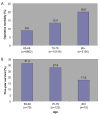Resection for esophageal cancer in the elderly
- PMID: 20066945
- PMCID: PMC2855305
- DOI: 10.1016/j.thorsurg.2009.06.002
Resection for esophageal cancer in the elderly
Abstract
Although studies differ in their definition of the older patient, increasing age, when considered as a continuum, is associated with greater operative mortality. Complication rates also seem to be significantly higher with advancing age, possibly because of limited physiologic reserve. As the understanding of risk factors for perioperative morbidity and mortality following esophagectomy has improved, investigators have sought to develop models for risk stratification in which patient age is a significant but not the sole determinant of prospective assessment of risk for complication or mortality. Such prognostic indicators, if validated among independent patient cohorts, can serve as useful adjuncts in decision making with appropriate clinical judgment. In addition, reported patient survival differs dramatically between rates reported by single centers and rates observed in population-based studies, with operative mortality rates typically lower in single-center reports. Although such reports usually are issued from groups with higher operative volume that might be a surrogate for surgical experience, it also is possible that the association between operation volume and improved outcomes reflects optimization of institution-specific infrastructure and/or clinical care pathways. As these processes of care evolve, they should be tailored with attention to differences in the care of older patients who have esophageal cancer. Whether widespread application of such processes of care then can lead to less perioperative mortality and fewer complications and to improved long-term survival remains untested.
Figures



References
-
- Ries L, Melbert D, Krapcho M, et al. SEER Cancer Statistics Review, 1975–2005. National Cancer Institute; Bethesda, MD: 2008. http://seer.cancer.gov/csr/1975_2005/ based on November 2007 SEER data submission, posted to the SEER web site.
-
- Chang AC, Ji H, Birkmeyer NJ, et al. Outcomes after transhiatal and transthoracic esophagectomy for cancer. Ann Thorac Surg. 2008;85(2):424–429. - PubMed
-
- Rice TW, Rusch VW, Apperson-Hansen C, et al. Worldwide esophageal cancer collaboration. Dis Esoph. 2009;22(1):1–8. - PubMed
-
- Paulson EC, Ra J, Armstrong K, et al. Underuse of esophagectomy as treatment for resectable esophageal cancer. Arch Surg. 2008;143(12):1198–1203. - PubMed
Publication types
MeSH terms
Grants and funding
LinkOut - more resources
Full Text Sources
Medical
Research Materials

